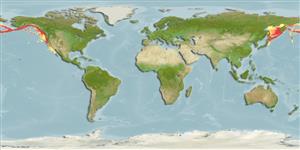Environment: milieu / climate zone / depth range / distribution range
ນິເວດວິທະຍາ
ສັດທະເລ ກ່ຽວກັບ(ຢູ່)ຊັ້ນນ້ຳໃນທະເລທີ່ເໜີອພື້ນດິນ; ປາທີ່ມີການເຄື່ອນຍ້າຍໃນສະເພາະມາະຫາສະມຸດ (Ref. 51243); ລະດັບຄວາມເລິກ 175 - 2740 m (Ref. 6793), usually 175 - 1450 m (Ref. 10935). Deep-water; 64°N - 23°N, 141°E - 109°W
North Pacific: Bering Sea coasts of Kamchatka, Russia and Alaska southward to Hatsu Shima Island, southern Japan and Cedros Island, central Baja California, Mexico in the eastern Pacific.
Length at first maturity / ຂະໜາດ / ນ້ຳໜັກ / Age
Maturity: Lm 60.3, range 58 - 62 cm
Max length : 120 cm TL ຕົວຜູ້/ບໍ່ມີເພດ; (Ref. 9988); common length : 80.0 cm TL ຕົວຜູ້/ບໍ່ມີເພດ; (Ref. 9988); ອາຍຸສູງສຸດທີ່ເຄຍລາຍງານມາ: 94 ປີ (Ref. 55701)
ຄີ (ໜາມ)ແຂງຢູ່ຫຼັງປາ (ທັງໝົດ) : 19 - 27; ຄີຫຼັງຂອງປາ (ຄີອ່ອນ) (ທັງໝົດ) : 16 - 20; ຄີ(ໜາມ) ແຂງຢູ່ຄີກົ້ນປາ
ກຸ່ມປາກະດູກແຂງ
ຄວາມຖີ່ຂອງກຸ່ມຖ່າຍທອດພັນ
ປາທີ່ມີການເຄື່ອນຍ້າຍຈາກທະເລໄປຫານ້ຳຈືດ ແລະນ້ຳຈືດຫາທະເລ
ປາທີ່ມີການເຄື່ອນຍ້າຍຈາກທະເລແລະໄປໄຂ່ຢູ່ນ້ຳຈືດ
ຄີກົ້ນຂອງປາ
ສັດທີ່ມີກະດູກສັນຫັຼງ
ການຖ່າຍທອດທາງກຳມະພັນຈາກພໍ່ແມ່ຫາລູກ: 3; ຄີກົ້ນຂອງປາ: 15 - 19. Dorsal fins well separated; 2nd dorsal fin sub equal to anal fin in size and form, and opposite in position. Reaches over 1 m in SL.
Adults found on mud bottoms, from 305 (Ref. 2850) to 2,740 m depth (Ref. 2850). Young-of-the-year juveniles are pelagic and found on the surface and near-shore waters (Ref. 28499). Generally localized, but some juveniles have been found to migrate over 2,000 miles in 6 or 7 years (Ref. 28499). Feed on crustaceans, worms and small fishes (Ref. 4925). Most of the catch is marketed in Japan (Ref. 28499). Utilized fresh, dried or salted and smoked (Ref. 9988), can be steamed, pan-fried, broiled, boiled, microwaved and baked (Ref. 9988). The liver oil is rich in vitamin A and D (Ref. 4925). Reported to reach 57 kg in Ref. 2850.
Eschmeyer, W.N., E.S. Herald and H. Hammann, 1983. A field guide to Pacific coast fishes of North America. Boston (MA, USA): Houghton Mifflin Company. xii+336 p. (Ref. 2850)
IUCN Red List Status (Ref. 130435: Version 2024-2)
Threat to humans
Harmless
Human uses
ການປະມົງ: ທີ່ມີການຄ້າສູງ; ການລ້ຽງສັດນ້ຳ: ການນຳໃຊ້ທີ່ເປັນໄປໄດ້ໃນອານາຄົດ; ຊະນິດປາທີ່ຖືກນຳໃຊ້ເຂົ້າໃນການຫາເພື່ອເປັນເກມກິລາ: ແມ່ນ; ຕູ້ປາ: ບ່ອນວາງສະແດງສັນນ້ຳຂອງລັດ
ເຄື່ອງມື
Special reports
Download XML
ແຫຼ່ງອີນເຕີເນັດ
Estimates based on models
Preferred temperature (Ref.
123201): 1.4 - 5.5, mean 2.5 °C (based on 599 cells).
Phylogenetic diversity index (Ref.
82804): PD
50 = 1.2500 [Uniqueness, from 0.5 = low to 2.0 = high].
Bayesian length-weight: a=0.01122 (0.00806 - 0.01563), b=2.98 (2.88 - 3.08), in cm total length, based on LWR estimates for this species (Ref.
93245).
ຊັ້ນເຂດຮ້ອນ (Ref.
69278): 3.8 ±0.2 se; based on diet studies.
Generation time: 5.8 (4.9 - 7.8) years. Estimated as median ln(3)/K based on 23
growth studies.
ຄວາມຢືດຢຸ່ນ (Ref.
120179): ຕຳ່ຫຼາຍ, ປະຊາກອນຕຳ່ສຸດທີ່ໃຊ້ເວລາສອງເທົ່າຫຼາຍກວ່າ 14 ປີ (K=0.2; tm=6; Fec=100,000; tmax=94).
Prior r = 0.11, 95% CL = 0.07 - 0.16, Based on 10 full stock assessments.
Fishing Vulnerability (Ref.
59153): Moderate to high vulnerability (49 of 100).
Climate Vulnerability (Ref.
125649): High vulnerability (58 of 100).
Nutrients (Ref.
124155): Calcium = 16.1 [9.1, 38.6] mg/100g; Iron = 0.46 [0.23, 0.90] mg/100g; Protein = 17 [16, 18] %; Omega3 = 0.567 [0.254, 1.631] g/100g; Selenium = 32.5 [14.5, 79.2] μg/100g; VitaminA = 8.27 [1.99, 36.01] μg/100g; Zinc = 0.27 [0.18, 0.42] mg/100g (wet weight);
